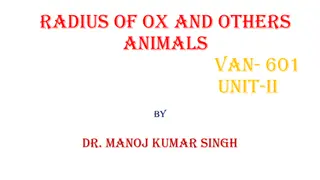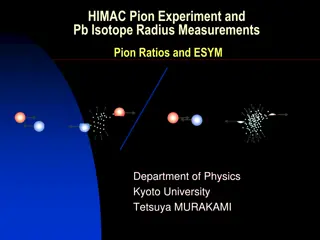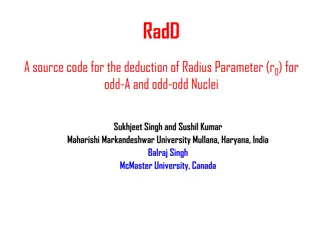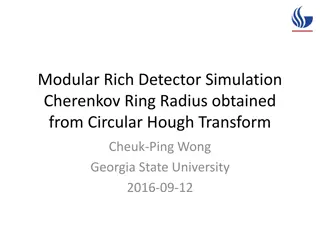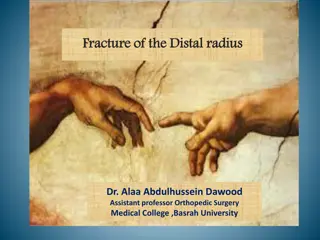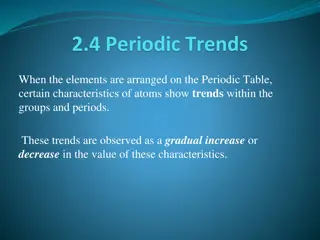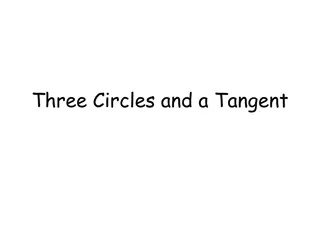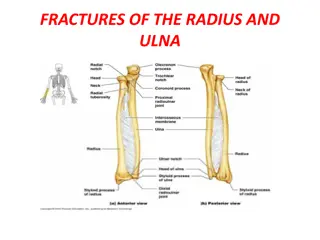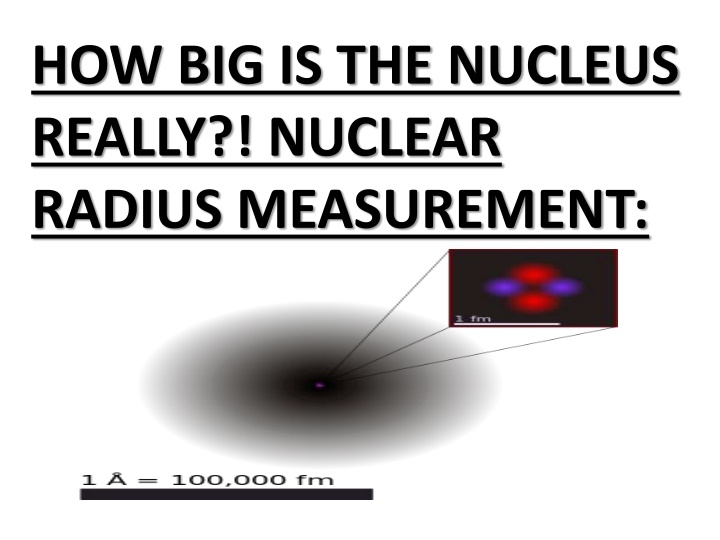
Nucleus Size Revealed: Rutherford's Estimates and Electron Scattering
Delve into the intricate world of nuclear physics as we explore the size of the atomic nucleus through historical experiments like Rutherford's scattering and modern electron scattering techniques. Learn about the challenges in defining the radius of the nucleus and how these experiments have shaped our understanding of this fundamental component of matter. Uncover the fascinating realms of subatomic particles and their interactions within the nucleus.
Download Presentation

Please find below an Image/Link to download the presentation.
The content on the website is provided AS IS for your information and personal use only. It may not be sold, licensed, or shared on other websites without obtaining consent from the author. If you encounter any issues during the download, it is possible that the publisher has removed the file from their server.
You are allowed to download the files provided on this website for personal or commercial use, subject to the condition that they are used lawfully. All files are the property of their respective owners.
The content on the website is provided AS IS for your information and personal use only. It may not be sold, licensed, or shared on other websites without obtaining consent from the author.
E N D
Presentation Transcript
HOW BIG IS THE NUCLEUS REALLY?! NUCLEAR RADIUS MEASUREMENT:
CONTENTS: 1. Introduction. 2. Rutherford s estimation: low energy scattering. 3. Electron scattering experiments. 4. Mirror nuclei method. 5. Muonic X-ray method.
INTRODUCTION: How big is the nucleus really? This was one of the first questions that came into the human mind as soon as the existence of nucleus become established with Rutherford s scattering experiment. The same experiment itself put some upper limit on the diameter of the nucleus to be of the order of a few femto-metre(fm-10-15 m). For comparison, size of the atom(distance from nucleus to outermost electron) is of the order of few Angstroms(10-10 m). So the nucleus is approximately 105 times smaller than atom as a whole. The problem of defining a radius for the atomic nucleus is similar to that of defining a radius for the entire atom; neither atoms nor their nuclei have definite boundaries. https://youtu.be/1keKrGoqUAg
Rutherfords estimation: low energy scattering: The first estimate of a nuclear charge radius was made by Hans Geiger and Ernest Marsden in 1909, under the direction of Ernest Rutherford at the Physical Laboratories of the University of Manchester, UK. The famous experiment involved the scattering of -particles by gold foil, with some of the particles being scattered through angles of more than 90 , that is coming back to the same side of the foil as the -source. Rutherford was able to put an upper limit on the radius of the gold nucleus of 34 femto-metres. Later studies found an empirical relation between the charge radius and the mass number, A, for heavier nuclei (A > 20): R r0A where the empirical constant r0of 1.2 1.5 fm can be interpreted as the Compton wavelength of the proton. This gives a charge radius for the gold nucleus (A = 197) of about 7.69 fm.
From the low-energy Rutherford-scattering experiment, when the impact parameter is zero, namely when the projectile collides head-on with the scattering center, the distance of closest approach is a minimum given by : ?0???=(??|)?2 ? (1) Such particles will, of course, be scattered backwards ( =?), and this distance of closest approach provides an upper bound on the size of the nucleus. The assumption is that low energy -particles cannot overcome the repulsive Coulomb barrier of the nucleus, and therefore cannot penetrate into the nucleus. Such low energy measurements yield relatively poor upper limits, typically, ???= 32?? and ???= 20fm. Electron Scattering experiments: The scattering of electrons from nuclei has given us the most precise information about nuclear size and charge distribution. The electron is a better nuclear probe than the alpha particles of Rutherford scattering because it is a point particle and can penetrate the nucleus.
For low energies and under conditions where the electron does not penetrate the nucleus, the electron scattering can be described by the Rutherford formula. The Rutherford formula is an analytic expression for the differential scattering cross section, and for a projectile charge of 1, it is As the energy of the electrons is raised enough to make them an effective nuclear probe, a number of other effects become significant, and the scattering behavior diverges from the Rutherford formula. The probing electrons are relativistic, they produce significant nuclear recoil, and they interact via their magnetic moment as well as by their charge. When the magnetic moment and recoil are taken into account, the expression is called he Mott cross section:
A major period of investigation of nuclear size and structure occurred in the 1950's with the work of Robert Hofstadter and others who compared their high energy electron scattering results with the Mott cross section. The illustration below from Hofstadter's work shows the divergence from the Mott cross section which indicates that the electrons are penetrating the nucleus - departure from point-particle scattering is evidence of the structure of the nucleus.
This productive period of research with electron scattering built the picture of the nucleus as a spherical distribution of positive charge of essentially constant density, so that the nuclear radius could be modeled by the relationship: 1 3 ? = ?0? (2)
Mirror nuclei method: Mirror nuclei are nuclei where the number of protons of element one (Z1) equals the number of neutrons of element two (N2) and the number of protons of element two (Z2) equals the number of neutrons in element one (N1), such that the mass number is the same (A = N1+ Z1= N2+ Z2). As that Z1= N2and Z2= N1, A = N1+ N2= Z1+ Z2. By making the substitution Z1= Z and Z2= Z 1, the mass number can be rewritten in the form 2Z - 1. Examples of mirror nuclei: Pairs of mirror nuclei have the same spin and parity. If we constrain to odd number of nucleons (A=Z+N) then we find mirror nuclei that differ from one another by exchanging a proton by a neutron. Interesting to observe is their binding energy which is mainly due to the strong interaction and also due to Coulomb interaction. Since the strong interaction is invariant to protons and neutrons one can expect these mirror nuclei to have very similar binding energies. 3H and3He: J = 1/2+ 14C and14O: J = 0+ 15N and15O: J = 1/2 24Na and24Al: J = 4+ 24mNa and24mAl: J = 1+
Consider the example of 11 B and 11C: They are very much similar at the nuclear level except that a neutron in 11B is replaced by a proton in 11C. Now inside these nuclei, all nucleons are usually arranged in a certain configuration of minimum energy called the ground state . If the nucleus is disturbed (for example, by being struck by a high-energy proton or other particle) it can be put into any number of other configurations, called excited states, each of which will have a characteristic energy that is higher than that of the ground state. The energies of these ground state and excited state can be determined experimentally using accelerators like Van de Graaff generators.
Looking at the above energy level diagram, we see that, The ground state of 11C is 1.982 MeV higher than that of 11B. The striking similarity of the pattern of the energy levels of 11B and 11C is surely not just a coincidence. It must reveal some physical law. It shows, in fact, that even in the complicated situation in a nucleus, replacing a neutron by a proton makes very little change. This can mean only that the neutron-neutron and proton-proton forces must be nearly identical. Only then would we expect the nuclear configurations with five protons and six neutrons to be the same as with six protons and five neutrons. The nuclei in these pairs differ from each other only in that a proton in one is exchanged for the neutron in the other. There is strong reason to believe that the force between nucleons does not differentiate between neutrons and protons. consequently, the nuclearpart of the binding energy of two mirror nuclei must be the same. Hence, the mass difference of two mirror nuclei can be due only to the difference between the proton mass and the neutron mass, and the different Coulomb energies of the two. This can be used to find the radius of the two nuclei (assumed to be the same), thus:
In order to check this idea, or rather to find out what the consequences of this idea are, we first consider the difference in the ground-state energies of the two nuclei. To take a very simple model, we suppose that the nuclei are spheres of radius r (to be determined), containing Z protons. If we consider that a nucleus is like a sphere with uniform charge density, we would expect the electrostatic energy to be: ? =3 5 where e is the elementary charge of the proton. Since Z is five for 11B and six for 11C, their electrostatic energies would be different. With such a small number of protons, however, Eq. (3) is not quite correct. If we compute the electrical energy between all pairs of protons, considered as points which we assume to be nearly uniformly distributed throughout the sphere, we find that in Eq. (3) the quantity Z2 should be replaced by Z(Z 1), so the energy is: ? =3 5 4??? 5 ? If we knew the nuclear radius r, we could use (4) to find the electrostatic energy difference between 11B and 11C. But let s do the opposite; let s instead use the observed energy difference to compute the radius, assuming that the energy difference is all electrostatic in origin. (??)2 4??? (3) ?(? 1)?2 ?(? 1)?2 =3 (4)
That is, however, not quite right. The energy difference of 1.982 MeV between the ground states of 11B and 11C includes the rest energies that is, the energy mc2 of all the particles. In going from 11B to 11C, we replace a neutron by a proton and an electron, which have less mass. So part of the energy difference is the difference in the rest energies of a neutron and that of a proton plus an electron, which is 0.784 MeV. The difference, to be accounted for by electrostatic energy, is thus more than 1.982 MeV; it is: 1.982MeV + 0.784MeV = 2.766MeV. Using this energy in Eq. (4), for the radius of either 11B or 11C we find: ? = ?.?? ?? ?? m. This value is little different from the value computed from the equation: ? = ??A1/3 which turns out to be ?.?? ?? `??m. Muonic X-ray method: An exotic atom is an otherwise normal atom in which one or more sub-atomic particles have been replaced by other particles of the same charge. For example, electrons may be replaced by other negatively charged particles such as muons (muonic atoms) or pions (pionic atoms).[ Because these substitute particles are usually unstable, exotic atoms typically have very short lifetimes and no exotic atom observed so far can persist under normal conditions.
a muonic atom is an atom in which electron is replaced by a muon, which, like the electron, is a lepton. Since leptons are sensitive only to weak, electromagnetic and gravitational forces, muonic atoms are governed to very high precision by the electromagnetic interaction. Since a muon is more massive than an electron, the Bohr orbits are closer to the nucleus in a muonic atom than in an ordinary atom.
Stopping of negative muons in mater is accompanied by emission of so-called muonic X- rays . This radiation, similar to conventional electronic characteristic X- rays, is unique for each chemical element, but has much higher energy (up to ~10 MeV). Characteristic X rays : K and L lines.
Fine structure of characteristic X rays: due to spin orbit coupling
To observe the small energy differences in the isotope shifts, one of the common methods is to measure each spectrum of a series of isotopes of the same element simultaneously with another spectrum of a neighboring element with Z' = Z -1 or Z'= Z - 2 and use the lower-Z spectrum as a common reference to measure isotope shifts. From 1953 to 1964, the NaI scintillation spectrometers used as X-ray detectors did not possess enough resolving power to completely resolve even the fine structure of heavy nuclei, let alone the hyperfine structure. Nevertheless, the important conclusions reached from observations in that period were impressive: Nuclear size : From the observed 2p-1s transition energies, the size of the nucleus was greatly reduced from the previously accepted value of R=?0A1/3 where the value of R0 made more precise from 1.4 to 1.2 . For more information: https://youtu.be/qXi246lq6Rs https://youtu.be/qXi246lq6Rs https://youtu.be/4ivtgtanGpc https://youtu.be/4ivtgtanGpc






